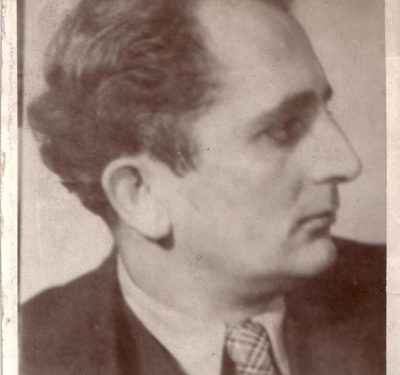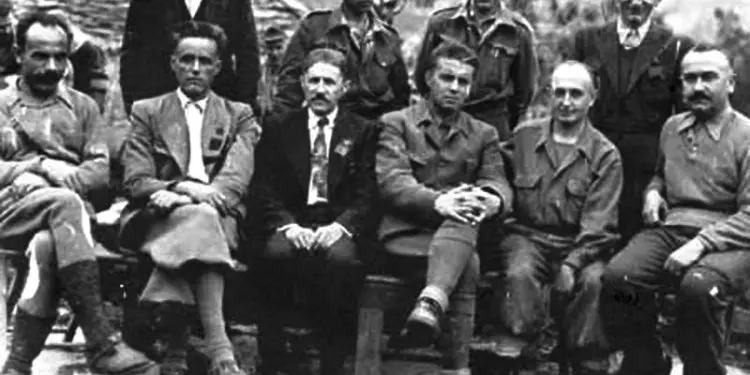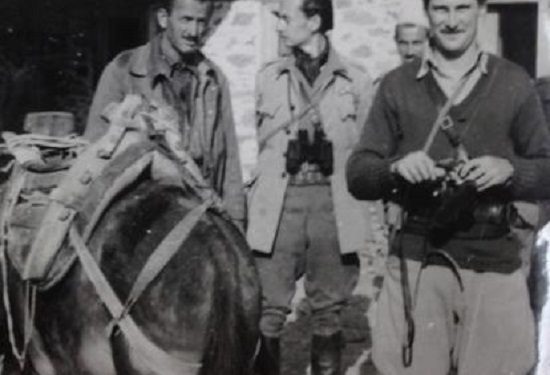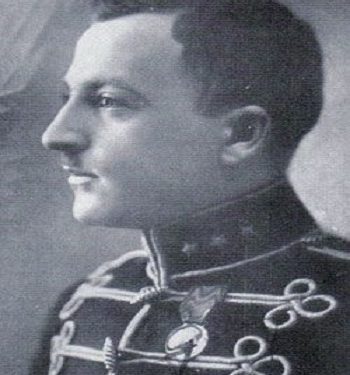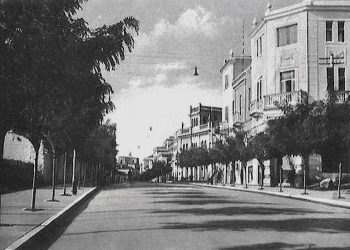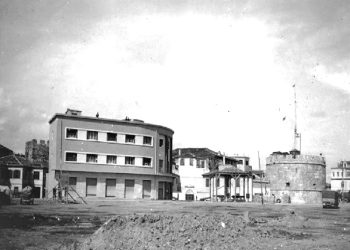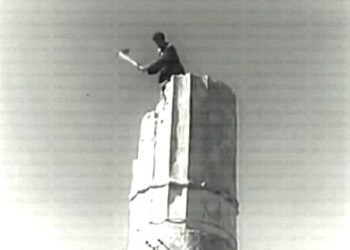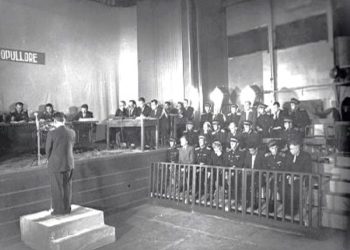From Dodë Progni
-The massacre of Hereç – criminal act of the Yugoslav and Albanian communist leadership-
I – THE “KRYEZIU” MOVEMENT
Memorie.al / “Kryeziu Movement” was the name of the Nationalist Anti-Fascist Movement, in Kosovo and Northern Albania, during the years 1940 – 1944, at the head of which were the brothers from Gjakova, Gani, Said and Hasan Kryeziu. Its strategic goal was the organization of the Anti-Fascist Movement in Kosovo, its liberation from Nazi-fascists, separation from Serbia and union with the mother country, Albania. The Kryeziu brothers, like hardly anyone else in Albania at that time, had understood since the beginning of the Second World War that the most possible way to solve the Albanian national problem was to secure support from a great Western power, such as Britain e Madhe, and that such a thing could only be achieved by fighting against the Nazis.
For the realization of their bold idea, Gani and Said Kryeziu, as early as 1940, entered into contact and cooperation with the people of the Directorate of Special Operations (SOE) of Great Britain in Belgrade, which had the task of promoting anti-fascist resistance in occupied countries. With the help of the SOE, the Blacks, during the years 1940-1941, tried twice to organize the anti-fascist uprising in Kosovo and Albania, but failed, as a result of Greek and Yugoslav influence in the high spheres of British foreign policy.
The Greeks were not interested in an uprising that would lead to the liberation of Albania. A self-liberated and independent Albania would be an obstacle to the realization of their nationalist goals at the end of the war. Even for the Yugoslavs, an anti-fascist nationalist uprising in Kosovo, which would lead to its liberation, was undesirable. In such a case, Kosovo could secure British support for the self-determination of the Albanian people. Unfortunately, the high circles of British foreign policy maintained a negative attitude, for the sake of their special interests, in Greece and Yugoslavia at that time.
However, the “Kryeziu Movement”, during the years 1940 – 1941, which became a well-known anti-fascist driving force in Kosovo. On April 7, 1941, Gani Kryeziu and Oklei Hill, together with Abaz Kupin, Mustafa Gjinishin, Padër Lekë Lulin, Said Kryeziu, etc., organized in Tropoja, a large gathering of anti-fascist nationalists from Kosovo, Malësia e Gjakova, Hasi and Luma, where the “United Front of Resistance” was formed, and the beginning of the anti-fascist uprising in Albania was decided.
On April 8, 1941, about 300 armed forces, most of whom were Kosovar, and were known by the name “Kosova” Division, crossed the Prush and Morin Passes and entered Has, Bytyç, Gash and Krasniqe. After destroying all the border posts, those of the carabinieri and the fascist administration in these provinces, they turned to Nikaj-Merturi of Dukagjini, with the aim of attacking the Italian forces in the city of Shkodra. These forces were joined by many anti-fascist highlanders from Gashi, Bytyçi, Krasniqja and Nikaj-Merturi, increasing their number to about 1000 fighters.
Parallel, and at the same time, with the Albanian forces led by Gani Kryeziu, Abaz Kupi, Oklej Hill, etc., the Yugoslav army, which consisted of thousands of soldiers and officers, had undertaken the march towards Shkodra, against the Italians. About this offensive of the Yugoslav army, Oklei Hilli, was informed only a few days before its start. “It, as Hilli says, is thought to have been a part of the Yugoslav plan, to face the sudden Nazi invasion, a kind of countermeasure against the Italians.” But in fact, this unexpected action cost Kryeziu’s forces dearly.
After several days of marching in the mountainous and difficult terrain of Dukagjin, and after the fighting in Gur te Kuq, Prekal, Ure e Shtrênti, Ure e Mesit, etc., against the forces of the carabinieri and groups of the local population, the so-called “Volunteers”. , who had joined the fascist forces to “protect” the province from the Serb-Montenegrin-Scythian invaders, as they called them, the forces coming from Yugoslavia, who everywhere passed through the highlands used only the Serbo-Croatian language.
The latter, on April 23, 1941, were forced to stop their march and retreat towards Kosovo and Yugoslavia, completely destroyed. Without going into the details of this complicated event, which would be the subject of a separate study, the fact must be acknowledged that one of the main causes that brought about the failure of Kryeziu’s forces was the participation of the Yugoslav army in this operation.
This is what Oakley Hill affirms, when he says: “It was the presence of the Yugoslav army that created the hostility that we encountered in the north-west of the northern mountains and that took away all our chances of success there …! The biggest punishment – he continues – was the entry of the Yugoslavs into Albania. If this had not happened, we would be able to move without noise and fuss, in the mountains and hills and find shelter by spreading out in the houses of the mountaineers…! They would not have had any reason to oppose our detachment, simple Albanians, especially when we were supported by Nikaj – Catholics and Krasniqja…! The thing was that the entire Far North knew about our presence there and that some thought that we were the tools of the Yugoslavs. This was the fatal punch”!
On the other hand, exactly those days when these forces started the march towards Shkodra, Nazi Germany invaded Yugoslavia. This completely changed the situation in favor of the Nazi-fascists, not only in Yugoslavia, but also in Albania and the entire Balkans, making it impossible to continue the initiative in question, for an anti-fascist uprising in Albania. The British project of December 1940 and April 1941, for the organization of the uprising in Kosovo and Albania, under the leadership of Gani Kryeziu, despite the fact that it failed, showed that Gani and his brothers, since that time, had become well-known figures of the Anti-Fascist Movement in Kosovo and Albania. Because of this activity, at the end of 1941, Ganiu and Saidi were arrested by the Germans, and after handing them over to the Italians, the latter interned them in Ventotene, Italy, where they stayed for two years.
During the period 1942-1943, the “Kryeziu Movement” was kept alive and led by Hasan Kryeziu, who had escaped deportation. He constantly kept close to him, a considerable number of supporters for propaganda and anti-fascist actions in Kosovo. In the second half of 1943, numerically and organizationally, it had become a serious anti-fascist war force, recognized in Kosovo and Albania.
Therefore, the communist leaders of the national-liberation movement, Enver Hoxha and Sejfulla Malishova, in August 1943, asked Hasan Kryezi to unite his forces with the partisan forces. Hasan Kryeziu opposed this request, because he maintained the idea of the independence of the nationalist forces from the communist command, because of the latter, they had close ties with the Serbian-Montenegro communists.
On December 3, 1943, Hasan Kryeziu met with the officer of the British mission in Albania, Major Peter Kemp, at the house of Mehmet Ali Bajraktar of Has, where they discussed the various problems of the Anti-Fascist War and agreed to undertake a mission together. special in Kosovo, for recognizing the possibilities of organizing armed resistance against the Germans with Albanian elements in Kosovo. With Kemp and Hasan Kryeziu, two of the leaders of the irredentist group of Kosovo met; Selman Riza and Ejup Binaku, both from Gjakova. They promised Kemp that they would support him during his trip to Kosovo, and that they would form a group of fighters with over 200 people, which would initially serve as a protector of the British military mission, during his trip to Kosovo, and later after that he would continue the war against the Nazi-fascists.
On January 7, 1944, in Gjakovë, Petër Kemp and Hasan Kryeziu organized a conference with a wide participation, where they were present; the mayor of the Municipality of Gjakova, the commander of the Albanian Army of Kosovo, Selman Riza, etc. There was a long and wide discussion about the organization of anti-fascist nationalist resistance in Kosovo. Selman Riza promised to prepare an immediate action against the Germans, while the commander of the Albanian Army of Kosovo promised to supply Selman Riza’s men with weapons and instructors.
Kemp’s two trips with Hasan Kryeziu, to Gjakova and Peje, on December 15-17, 1943, and January 13-22, 1944, were quite successful. They served for the recognition of the general situation there and for the drafting of a detailed plan of anti-fascist nationalist resistance in Kosovo. In these important moments, when new horizons and opportunities were opened for the “Kryeziu Movement”, for the expansion of the anti-fascist activity, Gani and Said Kryeziu return to its leadership. These, together with the prominent intellectual, anti-fascist and democrat, Llazar Fundo (Zoi Fundo), who returned together with the Black Chiefs from Ventotene, where he had been exiled for two years for anti-fascist activities, gave the movement new dimensions, as in the military plan, as well as in the organizational and political one.
During the year 1944, the Kryeziu Movement expands and deepens, takes on the physiognomy of a complete organized and armed nationalist anti-fascist force. It undertakes and carries out serious combat actions against Nazi fascists. Gani e Sahit Kryeziu and Zoi Fundo, who served as the chief political adviser in Kryeziu’s forces, after joining Peter Kempi, on January 22, 1944, moved from Gjakova to Bytyç in the Gjakova Highlands. They first settled in the house of Halil Hoxha, in Breg i Paci, where hundreds of people had gathered to welcome them. In Berishë and Dega, in this province, they contacted members of the British military mission, such as Andi Hendëz, Reginald Hibbert, Tony Nil, John Hiberdin, etc.
“Gani Kryeziu, – as Petër Kemp has pointed out in his book: “Without ranks without distinguishing marks”, (London 1958), – intended to put all his energy and talent in the service of the war, Gani Kryeziu, he adds, – that the only person, in these parts of Albania, who really wanted to fight against the Germans and who has the courage and the opportunity to do this, the only person who could raise the Kosovars to war”. While Reginal Hibbert (another officer of the British mission in Albania), in his book “Bitter Victory”, has emphasized that: “The brothers Kryeziu, Ganiu, Saidi and Hasani, were the only nationalists in Albania during the war, who were caught wholeheartedly behind the idea, to build the future Albania by fighting against the Germans”.
The American Strategic Services Office had the same consideration for Gani Kryeziu, which emphasized that: “In Kosovo, the most prominent political figure is Gani Kryeziu, who is closely related to his brother, Said. Ganiu is pro-English, a capable and smart man. He could do a lot for the allies because he has a lot of influence, and he is one of the few people who could achieve the creation of a common front in Kosovo, against the Germans”.
This willingness and the clear vision that the Black Leaders had for the Anti-Fascist War became the decisive factor in winning the sympathy and sincere support of the British allies.
On January 24-25, 1944, in the village of Paç in the province of Bytyç, the headquarters of Kryeziu’s forces, together with Peter Kemp, drew up the detailed plan of the general anti-fascist uprising in Kosovo. Excited by the understanding with the Blacks, Peter Kemp, on January 24, 1944, sends a telegram to the Command of the Allied Forces in Cairo, with which he requests supplies for the Blacks’ forces, and declares that: “Now we have a wonderful ally (formidablle) on the battlefield…! With these allies, – he adds, – our chances to organize a war of resistance in Kosovo increased immeasurably”.
In these moments, when Kosovo was feeling the imminent outbreak of anti-fascist uprising, led by the Black Black nationalists, the brazen anger and jealousy of the Kosovar and Serbo-Slavic communists appears. The headquarters of Kosmet was revolted by the visit of Kemp and Hasan Kryeziu to Kosovo, which was done without the approval and without the accompaniment of the partisans. They called this action a “challenge” and threatened the English missionaries that they would report them to Tito. Only 3-4 days later, they had reported to Tito, so Kempi received an ultimatum from Cairo: “Kemp. I must tactfully cut off all contacts with the Kryeznij and the irredentists, as Kemp’s activities in Kosovo were causing an unfavorable impression among Tito’s partisans…! Our relations with the Yugoslav partisans are of primary importance”.
It is clear from here that the threat of Mehmet and Fadil Hoxha, leader of the Kosmet Headquarters, was very serious and angry, so it had such a quick effect. They, together with Tito, in a completely unreasonable way tell him “Stop!” the anti-fascist uprising in Kosovo. And this happened exactly at the moment when the Blacks, supported by the British themselves and in cooperation with them, had taken up arms for the anti-fascist war in favor of the allies. The allied headquarters in Cairo, at Tito’s request, ordered the abandonment of Kryezinje. “This, as Peter Kemp pointed out with indignation, was not only a low thing, but also stupid (foolish-idiotllek), it was done to please Fadil and Mehmet Hoxha and a bunch of intriguing villains”.
However, the Blacks did not give up the anti-fascist war and the goal of a general uprising in Kosovo. Concentrated in Bytyҫ of the Gjakova Highlands, they organized their forces, with skilled fighters, patriots and well-known anti-fascists, from Kosovo, Bytyҫi, Gashi, Krasniqja, Nikaj – Merturi and Hasi.
From February 13, 1944, when “…a German military force crossed the Prush pass towards Bytyҫ”, to extinguish the armed resistance of communist and nationalist partisan forces in the Gjakova Highlands, until September 19, 1944, Kryeziu’s forces clashed time and time again with Nazi-fascist forces. In particular, during the month of June 1944, on the 8th, 14th, 17th, 18th, 20th of this month, Kryeziu’s forces fought fiercely against the Germans, causing them many casualties and injuries. In a report of the Albanian Gendarmerie Command of Kukës district, sent to the General Gendarmerie Command in Tirana, on June 17, 1944, it is stated that, in the Highlands of Gjakova (N/Tropojë Prefecture) “…As the center of the communist squads, have these places, and their quantity, approximately, consists of the following:
I – Gani Kryeziu, there are more than 200-300 well-armed people, with heavy and light machine guns, and the center is “Maya e Dobrejt”.
II – Sali Man Bajraktari, based in Markaj town of Krasniqe region, has more than 60 well-armed forces.
III – Fadil Hoxha and Mehmet Hoxha, based in Valbona, region of the Dragobi command post, well-armed with heavy and light machine guns… they have a force of more than 60 people…! While with dt. 21.06.1944, N/Prefecture of Tropoja, with an “extremely urgent” telegram, informed the Ministry of Internal Affairs in Tirana that: “In the area of this N/Prefecture, a large amount of partisan and communist detachments, headed by Gani Kryeziu, have gathered. based in Bytyҫ, but with the military power we have, we cannot withstand these squads…! Please arrange for the sending of an extraordinary military force, about 3,000 men…”!
Kryeziu’s forces, which then reached more than 400 people and in cases of important actions, more than 1000 people, were not formed nor did they stay as waiting forces and to avoid the encounter with the invaders. On the contrary, as it appears from the documentation of that time, they became forces of action and combat action face to face with the Germans. The province of Bytychi – the main base of Kryeziu’s forces, which supported and fought with them in the spring and summer of 1944, turned into a bloody battlefield, where large and small took part. Due to the cooperation with the forces of Kryeziu, Bytyçi became the object of several punitive operations by the Nazi-fascists. They, as a sign of revenge for the losses they suffered, burned Bytyçi’s 300 or so houses. Among them are 35 women, old people and children. Dozens were imprisoned and exiled, shot or hanged. Among them, the brothers Xhemal and Zeqir Halili, former members of Kryeziu’s forces, together with the well-known anti-fascist, Haxhi Avdyl Imeraj. After being caught by accident, they were hanged on a rope, in the middle of the city of Gjakova, in June 1944.
In the village of Zherke in Bytyç, in June 1944, the Nazis committed another very ugly crime. After the 11 members of Binak Meta’s family had been burned and killed, a three-month-old baby, who was sleeping tied to the cradle, was shot with 13 automatic bullets. The Kryeziu brothers showed their dedication to the Anti-Fascist War, not only with the actions and combat actions of their forces, but also in the efforts they made to cooperate with all those who wanted to fight against the invaders, including the communists. With all the different views, regarding the attitude towards the Serb-Slavic allies, and the Anglo-American ones, as well as for the construction of Albania after the war. The black leaders were ready to put aside all political disagreements and cooperate with the partisans.
They have the special merit that, without being part of any political party, they had a very clear vision for the Anti-Fascist War. They tried to put it in the function of liberating the country and solving the Kosovo problem. With the military leadership skills of Gani, the high political and intellectual level of Said, the enlightened and objective mind of Llazar Fundo, the bravery of Hasan and all the participants, the “Kryeziu Movement” became an authoritarian force of the Anti-Fascist War in the north of Albania. . For this, she won the sympathy and sincere support of allied British officers, such as Oakley Hill, Peter Kemp, David Smail, Anthony Simcox, Reginal Hibbert, etc. Regardless of the two-faced and ultimately negative policy of the British Foreign Office (FO), on the issue of Kosovo, these officers did their best to support the Blacks, for an anti-fascist nationalist uprising in Kosovo. Regarding this, the officer of the British mission, Davit Smaili, has affirmed that: “Even today, we are ashamed of the betrayal you did to our Albanian friends and comrades.” (it is about Kryezinjte. D.P.).
But the non-realization of this uprising came first, from the hostile attitude and destructive activity of the Albanian and Yugoslav communist leadership towards the “Kryeziu Movement”. However, the nationalist forces of Gani Kryeziu, who fought in Bytyҫ and, together with Bytyҫ, were an important factor in the Anti-Fascist War in the Highlands of Gjakova. They played an undeniable role in liberating it from the Nazi invaders on October 10, 1944. Whoever denies this, has denied the Anti-Fascist War of this province, which, with a population that made up about 13% of the population of Tropoja, has given To the Motherland, more than 50% of its martyrs, during the Anti-Fascist War. Memorie.al
The next issue follows





